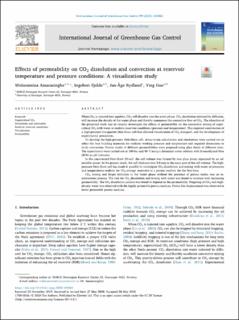Effects of permeability on CO2 dissolution and convection at reservoir temperature and pressure conditions: A visualization study
Peer reviewed, Journal article
Published version
Permanent lenke
https://hdl.handle.net/11250/2658259Utgivelsesdato
2020Metadata
Vis full innførselSamlinger
Originalversjon
International Journal of Greenhouse Gas Control. 2020, 99 103082-?. https://doi.org/10.1016/j.ijggc.2020.103082Sammendrag
When CO2 is injected into aquifers, CO2 will dissolve into the water phase. CO2 dissolution initiated by diffusion, will increase the density of the water phase and thereby commence the convective flow of CO2. The objective of the presented work was to visually investigate the effects of permeability on the convective mixing of supercritical CO2 with water at realistic reservoir conditions (pressure and temperature). This required construction of a high-pressure transparent Hele-Shaw cell that allowed visualization of CO2 transport, and the development of experimental procedures.
To develop the high-pressure Hele-Shaw cell, stress/strain calculations and simulations were carried out to select the best building materials for realistic working pressure and temperature and required dimensions to study convection. Porous media of different permeabilities were prepared using glass beads of different sizes. The experiments were carried out at 100 bar and 50 °C using a deionized water solution with Bromothymol blue (BTB) as pH indicator.
In the constructed Hele-Shaw 2D-cell, the cell volume was formed by two glass plates separated by an adjustable spacer. In the present study, the cell thickness was 5.0 mm in the main part of the cell volume. The high-pressure Hele-Shaw cell has made it possible to investigate CO2-dissolution and mixing with water at pressures and temperatures realistic for CO2-storage reservoirs in a porous medium for the first time.
CO2 mixing and finger initiation in the water phase without the presence of porous media was an instantaneous process. The rate for CO2 dissolution and mixing with water was found to increase with increasing permeability. The CO2 dissolution pattern was found to depend on the permeability. Fingering of CO2-rich high-density water was observed with the highly permeable porous medium. Piston-like displacement was observed in lower permeable porous medium.

